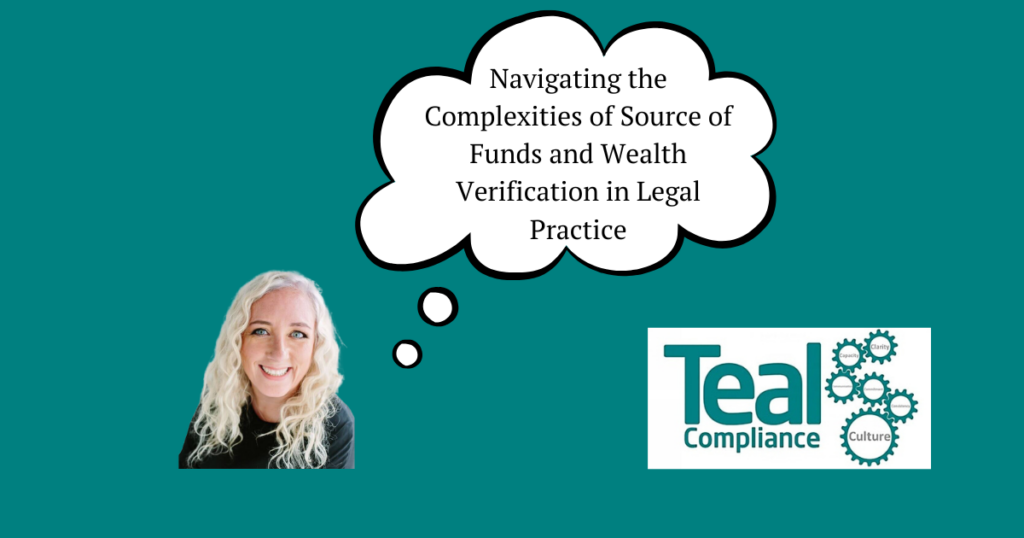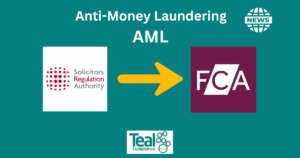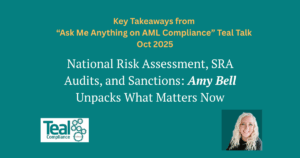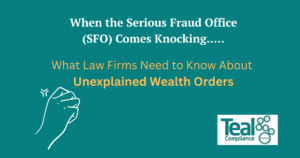As many of you will know I am the Chair of the Law Society’s Economic Crime Taskforce which allows me to share with Team Teal and our clients inside intelligence regarding updates on source of funds checks. Your source of funds checks are crucial for verifying the origins of money used in your regulated matters. These checks ensure that funds come from legitimate sources which help to combat money laundering and other financial crimes. Basically, it’s the way to stop the baddies.
The guide I’ve put together below explains the purpose of source of funds checks, it outlines their key components, and discusses best practices for keeping on top of your compliance.

Key Takeaways
- Source of Funds (SoF) checks are vital for understanding and verifying the legitimacy of funds in transactions, helping to prevent money laundering and ensure compliance.
- Key components of effective SoF checks include Client Due Diligence (CDD), Enhanced Due Diligence (EDD), and ongoing monitoring to identify high-risk transactions.
- Thorough documentation is crucial to evidence compliance, and firms must be prepared to report suspicious activities while avoiding ‘tipping off’ clients.
Understanding Source of Funds (SoF)
In the complex realm of law firm financial activities, Source of Funds (SoF) checks play an instrumental role in maintaining transparency and integrity for the regulators, your clients and your reputation.
These checks aim to mitigate the risk of financial crime by ensuring that all the funds used in transactions are legitimate and not derived from illicit activities.
But what exactly does SoF mean, and why is it so important in today’s financial landscape? SoF checks focus on verifying where the money for a specific transaction originates. This prevents criminals from using illegal funds and protects the financial system’s integrity.
Understanding the definition and importance of SoF checks reveals their critical role.
Definition and Importance
At its core, Source of Funds refers to the process of checking where the money for a particular transaction comes from. This involves ensuring that the funds are not from illegal activities and verifying their legitimacy. For instance, if a client is purchasing a property, the SoF check would involve verifying that the money used is not from criminal activities.
The importance of SoF checks cannot be overstated. They are essential in preventing money laundering and terrorist financing, which means your firm is proving it is maintaining the integrity of the financial system. Verifying the Source of Funds minimises the chance of criminal property being used in transactions, safeguarding a law firm’s reputation and the broader financial market.
Legal Framework
The legal framework surrounding Source of Funds checks is robust, designed to combat financial crime effectively. The Proceeds of Crime Act 2002 (POCA) is a key piece of legislation that makes concealing criminal property an offence along with being involved in an arrangement that facilitates criminal property and the acquisition, use and possession of criminal property. The Money Laundering Regulations (MLR) then set out the steps that are required to avoid becoming involved with the proceeds of crime. The MLR mandates that businesses must conduct SoF checks to ensure that funds used in transactions are legally obtained.
In addition, payments from certain high-risk countries might not be accepted due to the elevated money laundering risks they present. This highlights the importance of understanding the legal requirements and implementing thorough SoF checks to comply with anti-money laundering legislation and avoid severe penalties.
I can’t emphasise enough the importance of training for your compliance officers and support staff. TRAINING INFORMATION
Conducting effective Source of Funds checks involves several key components, each playing a super vital role in ensuring compliance and mitigating risks. These components include Client Due Diligence (CDD), Enhanced Due Diligence (EDD), and ongoing monitoring. Each of these elements works together to create a comprehensive approach to SoF checks.
Documentation is a vital part of this process, as it provides the necessary evidence to verify the source of funds. Depending on the risk level of the transaction, the type of documentation required can vary significantly. Keeping on top of updates and sanctions is so important because as you know, there’s always loads going on in AML!
Subscribe to Teal Compliance Newsletter HERE.
Exploring these components in detail reveals their significance.
Client Due Diligence (CDD)
Client Due Diligence (CDD) is the first line of defence in identifying and verifying clients to eliminate anonymity and identify potential risks of money laundering. This process involves obtaining official documents such as passports and utility bills to confirm the client’s identity. Regulation 28 mandates that firms must also scrutinise transactions throughout the client relationship to ensure they align with the client’s risk profile.
Implementing robust customer due diligence procedures is particularly important for high-risk transactions. It helps firms understand their clients’ backgrounds and transaction patterns, thereby identifying any anomalies that might indicate money laundering, i.e., ongoing monitoring.
Enhanced Due Diligence (EDD)
Enhanced Due Diligence (EDD) comes into play when dealing with clients who pose a higher risk, such as politically exposed persons (PEPs) or individuals linked to high-risk jurisdictions. EDD requires additional scrutiny and verification steps to ensure the legitimacy of the client’s source of wealth and funds.
When dealing with PEPs, extra vigilance is necessary to uncover potential connections to corruption or abuse of power. This includes verifying their source of wealth and funds to mitigate potential money laundering risks.
By implementing EDD, firms can better manage and mitigate the risks associated with high-risk clients.
Ongoing Monitoring
Ongoing monitoring is a continuous process that helps firms detect and address any suspicious activities promptly. Continuous transaction monitoring allows firms to identify and prevent potential money laundering activities. This ongoing vigilance is crucial for effective risk management and compliance with anti-money laundering regulations.
Transactions involving high-risk jurisdictions require heightened scrutiny and additional verification steps due to the increased money laundering risks they present. Firms must conduct thorough investigations and maintain a thorough understanding of their clients’ financial histories to ensure compliance and mitigate risks.
Documentation and Evidence Requirements
Thorough documentation is the backbone of effective Source of Funds checks. Acceptable documentation for verifying SoF can include bank statements, recent tax returns, and proof of sale for acquired assets. The type of documents required can vary based on the assessed risk level of the transaction.
Documenting all interactions and materials received during the SoF verification process is crucial for compliance. This documentation helps firms verify legitimate financial activities and provides a defence against potential regulatory scrutiny.
Bank Statements and Pay Slips
Bank statements and pay slips are fundamental documents for verifying the source of funds. Recent bank statements that reveal the source of funds are significant for verifying financial activities. Typically, a minimum of six months of bank account statements might be requested during the verification process, although more extended periods may be required for thorough scrutiny and checks.
Pay slips and employment contracts are also essential for verifying employment income. These documents provide a clear picture of a client’s financial stability and help ensure compliance with anti-money laundering regulations.
Letters Confirming Employment Income
Letters confirming employment income are another major piece of evidence for SoF checks. These letters serve as official documentation of a client’s regular income, providing important information for verifying financial stability. Documents needed for employment income verification can include official pay slips and contracts from the employer.
Ensuring that these documents are accurate and up-to-date is vital for compliance. They help verify that the funds used in transactions are legitimate and not derived from illegal activities.
Loans from Regulated Financial Institutions
Loans from regulated financial institutions provide a reliable source of funds, helping to establish financial security in transactions. Different types of loans, such as personal loans, mortgages, and auto loans, can serve as acceptable proof of funds, provided they are well-documented. It’s all about the evidence!
Essential documentation for validating loans as a source of funds includes loan agreements, statements showing the release of funds, and repayment schedules. Thorough verification of these loans is needed to comply with the AML regulations as well as to prevent the financial criminals.
Handling High-Risk Transactions
Handling high-risk transactions requires a meticulous approach to ensure that the funds used are legitimate. Legal regulations (Money Laundering) mandate that law firms conduct enhanced monitoring and due diligence when dealing with clients identified as high-risk. This involves obtaining additional details to explain the nature of significant deposits and scrutinizing large or regular deposits in bank statements.
It’s worth having a look at Teal’s partnership programmes with have with law firms:
AML SORTED Programme (for medium to large sized law firms) CLICK HERE
AML SORTED Programme (for small law firms) CLICK HERE
Regulatory SORTED Programme (for medium to large sized law firms) CLICK HERE
Regulatory SORTED for Small Firms Programme (for small law firms) CLICK HERE
More information may be requested if there are large cash payments or funding from third parties without a clear purpose, as these raise significant concerns and warrant closer investigation.
Identifying Red Flags
Identifying red flags is crucial for detecting potential money laundering activities. Clients who are secretive about their identity or the purpose of the transaction may display a red flag for suspicion. Unusual payments from third parties or large cash transactions are also indicators that warrant further investigation.
Transactions that exhibit unusual features, such as excessive urgency or last-minute changes, can be grounds for further inquiry. Early identification of these red flags allows firms to take appropriate measures to ensure compliance and mitigate risks.
Enhanced Scrutiny for High-Risk Jurisdictions
Transactions involving high-risk jurisdictions and high-risk third countries require enhanced scrutiny to mitigate risks. Risk assessments for these transactions should analyse various factors, including country risk and customer risk profiles. Conducting thorough due diligence is crucial to ensure compliance with anti-money laundering regulations.
The level of due diligence required for counter-parties in high-risk transactions should be determined based on the risk assessment conducted. This helps firms manage and mitigate the risks associated with high-risk jurisdictions.
Politically Exposed Persons (PEPs)
Politically Exposed Persons (PEPs) are individuals who hold prominent public positions and are subject to additional regulatory scrutiny due to their potential for corruption or misuse of entrusted power. When dealing with a politically exposed person, it is crucial to conduct enhanced due diligence to identify and mitigate associated risks.
Transactions involving PEPs require enhanced scrutiny to ensure compliance with anti-money laundering regulations and identify any irregularities. This includes looking for information about corruption or misuse of government funds when conducting due diligence on PEPs.
Don’t forget, the definition of a PEP also extends to immediate family members and known close associates.
Practical Tips for Effective SoF Checks
Conducting thorough Source of Funds checks requires a clear understanding of both the client’s financial history and the transaction in question. Businesses must implement internal controls and monitoring systems tailored to their size and complexity to meet AML regulations.
Here are some practical tips to help you navigate this process effectively.
Tailoring Enquiries Based on Risk Profiles
Employing a risk-based approach is essential for managing high-risk clients and/or matters effectively. It is important to establish if the funds are consistent with the client’s risk profile and the nature of the transaction.
Client and matter risk assessments are critical for apply a risk based approach to Source of Funds enquiries to match the specific risks associated with a client or matter. By tailoring enquiries based on risk profiles, firms can improve compliance and implement efficient risk management strategies.
Utilising Technology Providers
Choosing an appropriate technology provider is crucial for streamlining due diligence processes effectively. Factors for choosing a digital client due diligence provider include assurance levels, system understanding, and training requirements.
Staff must be trained on entering information correctly and interpreting results. When deciding to use a digital client due diligence provider, consider assurance levels, system understanding, staff training, and decision-making responsibility.
Documentation and Record-Keeping
Effective documentation and record-keeping are essential for compliance with anti-money laundering regulations. Documenting all interactions and materials received during the verification of Source of Funds is crucial for compliance. This includes questions asked, answers given, and supporting material received during the SoF verification process.
Detailed records of Source of Funds checks help firms defend against potential regulatory scrutiny and demonstrate compliance efforts. Thorough documentation of inquiries and responses is crucial for compliance and audit purposes.
It is important to ensure that any who picks up the file would be able to understand the person who is dealing with the matters understanding of where the Source of Funds are coming from.
Addressing Concerns and Reporting Suspicious Activity
Addressing concerns and reporting suspicious activity are critical components of a robust anti-money laundering framework. Large amounts of private funding that do not align with the client profile can raise concerns. This is particularly true if there is no legitimate explanation, as it may indicate potential money laundering during Source of Funds checks. If a client cannot provide paperwork for their source of funds, continue assessing the situation; lack of documentation does not automatically imply money laundering but further enquiries may be required.
If there is a suspicion of criminal property, it is critical to consider making a Suspicious Activity Report (SAR) to the National Crime Agency and determine if consent is needed to proceed. For specific compliance questions or uncertainties regarding suspicious activities, contact the Professional Ethics team or seek independent legal advice. Contact the Professional Ethics team or seek independent legal advice.
When to Submit a Suspicious Activity Report (SAR)
Suspicious Activity Reports (SARs) are submitted to the National Crime Agency and other relevant authorities when a regulated entity suspects that a client is involved in prohibited activities. Submit SARs when there is reasonable suspicion of money laundering or terrorist financing based on the client’s transaction patterns or other behaviours.
Failing to report suspicious activities can result in legal implications and potential sanctions against the reporting entity. SARs are governed by a different regime than sanctions reporting.
Avoiding ‘Tipping Off’
The term ‘tipping off’ refers to the act of disclosing to a client that they are under investigation after a report has been filed, either internally or externally, which is prohibited by law. Avoiding tipping off is crucial to protect both the firm and the client from potential repercussions and can result in prejudicing an investigation.
Communicate with clients in a manner that does not arouse suspicion. General language about compliance processes, without directly referencing any enquiries, helps avoid ‘tipping off’.
Internal policies should guide staff on handling client communication related to sensitive compliance issues while preventing breaches of confidentiality.
Compliance with Anti Money Laundering Legislation
Compliance with anti-money laundering legislation is a cornerstone of financial integrity. Source of funds obligations are part of a broader framework to ensure financial integrity and compliance with anti-money laundering regulations. Thorough Source of Funds checks ensure compliance with anti-money laundering regulations and help avoid financial penalties.
The Solicitors Regulation Authority (SRA) uses a risk-based approach for AML supervision. Firms should refer to the Legal Sector Affinity Group guidance for information on how to comply with the money laundering regulations.
Role of the Money Laundering Compliance Officer (MLCO)
MLCO and MLRO Compliance Officer TRAINING
Risk assessments should consider minimizing exposure to sanctions breaches. When suspecting proceeds of crime or money laundering, it is necessary to file a Suspicious Activity Report (SAR). A SAR is required to be submitted when there is a belief that funds are linked to crime or money laundering.
Independent Audits and Assessments
Independent audits are required under Regulation 21 of the MLR depending on the firm’s size and nature. Firms can record their reasoning if they believe an independent audit is not necessary however, the SRA have previously said that the majority of firms they supervise will require one.
Independent audits help firms ensure their AML policies and procedures are effective and compliant with regulations. These audits provide an objective assessment of the firm’s AML compliance framework and identify areas for improvement.
Summary
In summary, Source of Funds checks are an essential component of the fight against the baddies who operate in financial crime. By understanding and implementing best practices in SoF checks, businesses (and make no mistake, law firms are businesses!) can ensure compliance with anti-money laundering regulations, POCA and protect themselves from potential risks.
Remember, thorough documentation, ongoing monitoring, and a risk-based approach are key to effective SoF checks. Stay vigilant, stay compliant, and contribute to a transparent and secure financial system.
As a final sign off, data for root cause analysis in AML compliance is why I built TEAL TRACKER software.
The Tracker’s features include:
- Incident management – Report incidents and suspicious circumstances
- Training needs – Record training needs, training record and training plan
- File reviews – Records of all file reviews and steps forward
- Gifts and hospitality register – Register of any gifts of hospitality received
- Own conflicts register – Register of affiliations to carry out conflict checks against
- Undertakings register – Details of the firms’ undertakings
- High-risk client register – Register of any high-risk clients
Book a DEMO with our brilliant team HERE.
Please remember that Teal Compliance is your go-to AML and Risk Management Partner and we have a variety of packages available to support you, your colleagues and of course, your clients!
To find out more, click HERE and come what may, we look forward to supporting you soon.
Ask Teal: Consultation Services
Policy Review & Writing Services
Let us support you, your team and your clients.





